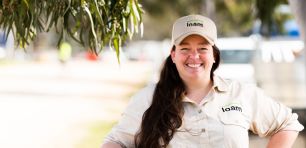
Image: Michele Stansfield, CEO of Cauldron. Source: supplied
In the verdant landscapes of Orange NSW, change is bubbling — quite literally. Cauldron, a precision fermentation startup that launched earlier this year, is brewing up plans to change the future of Australian industry.
After securing $10.5 million in seed funding in March, Cauldron is on a path to scale up and commercialise.
It’s already providing its precision fermentation services to other Australian startups trying to make the future of food and packaging more sustainable. Its clients include Eden Brew, ULUU and Nourish Ingredients – all of which have landed substantial capital raises in the last 12 months.
Nourish also launched its animal-free fat, which utilised Cauldron technology, a few weeks ago at SXSW Sydney.
But it isn’t content to stop there. As Cauldron moves into its commercialisation phase, it has its eyes set on traditional mining regions across the country — including Mackay — to help supplement the industry and jobs.
Cauldron’s journey from a seed-funded vision to a potential industry cornerstone in regional Australia underscores a growing trend in the agtech space. There’s an increasing blend of traditional industries and cutting-edge technology, infused with an astute sense of environmental stewardship and regional development.
Why Mackay?

Image: Tegan Jones
Back in January, the Queensland government invested $528,000 into Cauldron to help build Future Foods BioHub in Mackay
“The proposed fermented Future Foods contract manufacturing facility will provide the large-scale fermentation capacity needed by Future Foods fermentation companies to produce their products at scale,” Deputy Premier and Minister for State Development Steven Miles said at the time.
“The proposed $300 million facility will provide the anchor infrastructure Queensland needs to catalyse a new commercial-scale industry, complement the region’s agricultural and manufacturing strengths, protect existing jobs in the sugar industry, diversify the local economy and create new local jobs.”
The region’s sugar industry provides a ripe opportunity for precision fermentation processes, which can convert it into a large number of valuable products, including sustainable bio-materials for industries as varied as pharmaceuticals and agriculture.
“The reason we’re looking at Mackay is that they have an amazing feedstock up there… the sugar industry is looking to grow and diversify. That’s very interesting to the Queensland government,” Cauldron co-founder and CEO, Michele Stansfield, said during a recent site visit in Orange.
But it’s not just the sugar industry that’s catching Cauldron’s eye. With a foresighted approach, Stansfield speaks of the longevity of Mackay’s mining industry and the imperative to repurpose its workforce,
“How long can the mining industry survive up there? Can we redeploy those staff to be able to grow food?,” she said.
According to Stansfield, Cauldron is looking to “co-locate on existing agricultural businesses sites. So sugar mills, flour mills, and we might be looking at co-locating with a winery,” says Stansfield. This approach not only leverages existing infrastructure but also embeds the company within the fabric of regional industries, potentially reducing capital expenditure and fostering community ties.
But it’s not just Queensland that Cauldron is interested in. There are other traditional mining areas across the country that are looking at industry pivots, especially in regards to sustainability – including the Hunter Region in Cauldron’s home state of New South Wales.
“We’d love to go to the hunter region,” Stansfield said.
“We would love to investigate this opportunity with the NSW government as they look to redeploy the mining industry.”
According to Cauldron, it is also interested in looking at Western Australia for similar reasons.
Cauldron has a modular approach to innovation

Inside the lab at Cauldron in Orange. Image: Tegan Jones
According to Cauldron, as it builds out 100 kilolitre facilities in regional areas, it’s important to create tangible, scalable models that move beyond the lab to real-world applications.
“When we build those facilities, what we’ll end up with is a profit-sharing arrangement with our customers. That’s really what we’re aspiring to build and we’re making that in a modular way in regional Australia,” Saurabh Das, head of operations at Cauldron, said.
“Michele’s commentary has always been that if you can’t move things on a forklift if you can’t show it in some real tangible scale, then it’s very difficult to prove the model to our customers.
“So this facility really very much is launch and leave – prove the technology and then we start building the commercial scale industrial capability that the industry doesn’t really have today.”
When asked about global expansion, particularly into the US, the candid response from Stansfield is, “We’ll follow the money.”
But there’s a depth to this quip that resonates with the global sustainability challenge they aim to tackle.
“This is a global problem; it’s not an Australian problem. We need to be where our customers want us to be and where the market is,” Stansfield said.
As for the challenges of funding compared to sectors like SaaS – which have done well on the VC front over the past decade – Stansfield acknowledges the unique difficulties.
“It’s a really challenging model when it comes to a new company,” she said.
However, the technology has aided the business.
“The fact that we have these disruptive technologies – VCs have gone in on this. But ultimately, we need to transition into infrastructure finance or equity as soon as humanly possible because just from the sheer volumes of money that need to go into this, VC can’t do that forever.
“So that’s why we’re looking at working with governments to really co-fund these facilities.”
Despite its global aspirations, Cauldron hasn’t forgotten where it came. It isn’t planning to leave, but it also needs room to grow.
“Orange is where we were born and raised and there are no immediate plans to change that situation. But this really is an R&D facility where we develop technologies and the factories will be at other locations.”
SmartCompany travelled to Orange as a guest of SparkLabs Cultiv8.
Handpicked for you

Why Loam Bio is prioritising Orange as it goes global



COMMENTS
SmartCompany is committed to hosting lively discussions. Help us keep the conversation useful, interesting and welcoming. We aim to publish comments quickly in the interest of promoting robust conversation, but we’re a small team and we deploy filters to protect against legal risk. Occasionally your comment may be held up while it is being reviewed, but we’re working as fast as we can to keep the conversation rolling.
The SmartCompany comment section is members-only content. Please subscribe to leave a comment.
The SmartCompany comment section is members-only content. Please login to leave a comment.